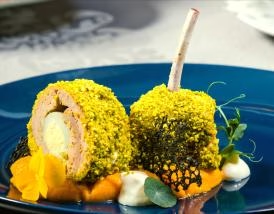Pork loin is a common cut used in home cooking. Loin can be divided into three types: large loin, medium loin, and petite loin. The texture of the loin varies slightly depending on where it’s cut. How can you make your loin chops even more tender?
Using three steps, including treating the fascia and pounding, you can achieve a tender texture for your loin chops.
Loin Types – The Slenderest Pork Family
Well, the pork cuisine world even has a family of supermodels, each with an enviable low body fat level.
Loin Loin
As the tallest of the family, the loin loin naturally attracts the most attention, making it synonymous with “loin loin.” Located on the pig’s back, the loin loin has denser muscle fibers, making it suitable for short cooking times to prevent excessive loss of juices and a dry texture.
The loin can be divided into three sections: the front, middle, and back. The front and middle sections have a pinkish-red color and a firmer texture, while the back section has a pink and dark red color and a more tender texture.
Taste: Medium
Suitable Dishes: Pan-frying, boiling, stir-frying, deep-frying, grilling
Middle Loin
Compared to the slender shape of other members of the loin, the rounded and plump middle loin has earned it a unique nickname: “rat meat.”
The low-fat and tender middle loin is highly sought-after because, located inside the hind leg, it is a prized item, with only two small pieces available per pig.
Taste: Tender
Suitable Dishes: Pan-frying, boiling, stir-frying, deep-frying, grilling
Small Loin
The naturally beautiful small loin is located between the pig’s back and abdomen, where it receives the least exercise. It is commonly known as “tender loin” or “pork fillet.”
It shares the characteristics of being low in fat and tender, and since it’s only two small pieces from the entire pig, it’s often used in top-notch Japanese deep-fried tonkatsu.
Texture: Tender
Suitable Dishes: Pan-frying, boiling, stir-frying, deep-frying, grilling
Preparing for Tender Pork Cutlets
Pork belly, large loin, middle loin, and small loin are the most commonly used cuts for pork cutlets. Large loin is the most popular choice because it easily cuts into the oval slices needed for pork cutlets.
However, large loin has denser muscle fibers and a large area of fascia, so it’s recommended to pound the meat loose before cooking to make it easier to chew.
In addition, to make this recipe easy for readers to use at home, Step 3 of this article will be demonstrated using a standard knife. If you already have a professional meat hammer, Step 3 can simply be pounded evenly on both the front and back.
[Instructions]
- Place the white fascia of the tilapia facing upwards, allowing you to cut through the firmer fascia first, creating a smooth cut.
- Evenly cut through the white fascia of the tilapia to prevent the cutlet from curling up due to heat contraction.
- Use the back of the knife to evenly strike the front and back of the cutlet in a crisscross pattern to break down the muscle fibers and achieve a more tender texture.


Leave a Reply